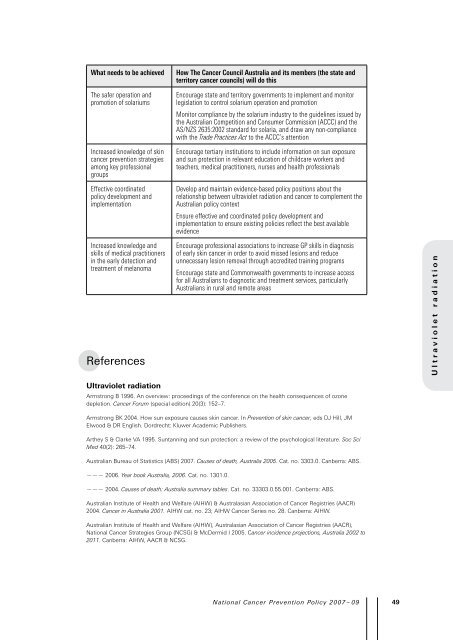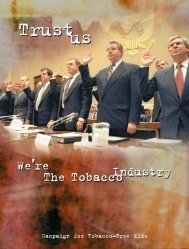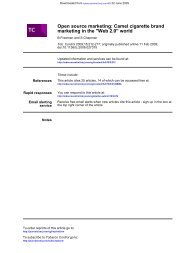National Cancer Prevention Policy - Tobacco Control Supersite
National Cancer Prevention Policy - Tobacco Control Supersite
National Cancer Prevention Policy - Tobacco Control Supersite
Create successful ePaper yourself
Turn your PDF publications into a flip-book with our unique Google optimized e-Paper software.
What needs to be achieved How The <strong>Cancer</strong> Council Australia and its members (the state and<br />
territory cancer councils) will do this<br />
The safer operation and<br />
promotion of solariums<br />
Increased knowledge of skin<br />
cancer prevention strategies<br />
among key professional<br />
groups<br />
Effective coordinated<br />
policy development and<br />
implementation<br />
Increased knowledge and<br />
skills of medical practitioners<br />
in the early detection and<br />
treatment of melanoma<br />
References<br />
Ultraviolet radiation<br />
Encourage state and territory governments to implement and monitor<br />
legislation to control solarium operation and promotion<br />
Monitor compliance by the solarium industry to the guidelines issued by<br />
the Australian Competition and Consumer Commission (ACCC) and the<br />
AS/NZS 2635:2002 standard for solaria, and draw any non-compliance<br />
with the Trade Practices Act to the ACCC’s attention<br />
Encourage tertiary institutions to include information on sun exposure<br />
and sun protection in relevant education of childcare workers and<br />
teachers, medical practitioners, nurses and health professionals<br />
Develop and maintain evidence-based policy positions about the<br />
relationship between ultraviolet radiation and cancer to complement the<br />
Australian policy context<br />
Ensure effective and coordinated policy development and<br />
implementation to ensure existing policies reflect the best available<br />
evidence<br />
Encourage professional associations to increase GP skills in diagnosis<br />
of early skin cancer in order to avoid missed lesions and reduce<br />
unnecessary lesion removal through accredited training programs<br />
Encourage state and Commonwealth governments to increase access<br />
for all Australians to diagnostic and treatment services, particularly<br />
Australians in rural and remote areas<br />
Armstrong B 1996. An overview: proceedings of the conference on the health consequences of ozone<br />
depletion. <strong>Cancer</strong> Forum (special edition) 20(3): 152–7.<br />
Armstrong BK 2004. How sun exposure causes skin cancer. In <strong>Prevention</strong> of skin cancer, eds DJ Hill, JM<br />
Elwood & DR English. Dordrecht: Kluwer Academic Publishers.<br />
Arthey S & Clarke VA 1995. Suntanning and sun protection: a review of the psychological literature. Soc Sci<br />
Med 40(2): 265–74.<br />
Australian Bureau of Statistics (ABS) 2007. Causes of death, Australia 2005. Cat. no. 3303.0. Canberra: ABS.<br />
——— 2006. Year book Australia, 2006. Cat. no. 1301.0.<br />
——— 2004. Causes of death: Australia summary tables. Cat. no. 33303.0.55.001. Canberra: ABS.<br />
Australian Institute of Health and Welfare (AIHW) & Australasian Association of <strong>Cancer</strong> Registries (AACR)<br />
2004. <strong>Cancer</strong> in Australia 2001. AIHW cat. no. 23; AIHW <strong>Cancer</strong> Series no. 28. Canberra: AIHW.<br />
Australian Institute of Health and Welfare (AIHW), Australasian Association of <strong>Cancer</strong> Registries (AACR),<br />
<strong>National</strong> <strong>Cancer</strong> Strategies Group (NCSG) & McDermid I 2005. <strong>Cancer</strong> incidence projections, Australia 2002 to<br />
2011. Canberra: AIHW, AACR & NCSG.<br />
<strong>National</strong> <strong>Cancer</strong> <strong>Prevention</strong> <strong>Policy</strong> 2007 – 09<br />
4<br />
U l t r a v i o l e t r a d i a t i o n




